Rice milk is a popular alternative to cow’s milk, but is it low FODMAP? If you’re following a low FODMAP diet for digestive health, it’s important to know what foods are safe and which ones to avoid. In this article, we will discuss whether rice milk is low FODMAP and provide tips for using it in recipes.
FODMAP stands for “Fermentable Oligosaccharides, Disaccharides, Monosaccharides and Polyols”, which are specific types of carbohydrates that are poorly absorbed in the small intestine. A FODMAP diet is a low-FODMAP diet which is used to manage digestive symptoms such as bloating, gas and abdominal pain.
What is Rice Milk?
Rice milk is a vegan-friendly alternative to cow’s milk. It is made from milled rice, water, and often a sweetener like sugar or honey. It is usually fortified with vitamins and minerals to make it nutritionally similar to dairy milk. Rice milk has a mild flavor and creamy texture that makes it favored by those who don’t like the taste of almond or soy milk.
Rice milk contains no lactose and is therefore suitable for those with lactose intolerance. It also has less protein than cow’s milk, but more carbohydrates and fiber. The carbohydrates in rice milk come from starches, which may be beneficial for digestive health as they’re slowly digested and absorbed into the body.
Rice milk generally has fewer calories than other types of non-dairy milks, but it may not be suitable for those who are trying to lose weight as its high carbohydrate content could cause blood sugar levels to spike. As rice milk doesn’t contain any animal products it can be used in vegan recipes instead of dairy products, such as in cakes or smoothies.
Though rice milk may not provide all the same benefits as cow’s milk, it can be a good option for those who are looking for an alternative source of calcium and other essential nutrients without consuming animal products.
Is Rice Milk Low FODMAP?
Rice milk is becoming an increasingly popular alternative to dairy milk, and it is often seen as a healthier option. However, when it comes to following a low FODMAP diet, it can be difficult to know whether rice milk is suitable. Fortunately, rice milk has been tested and approved as low FODMAP by the Monash University FODMAP team. This means that you can enjoy rice milk without worrying about triggering symptoms of irritable bowel syndrome (IBS).
Rice milk is made from milled white or brown rice and water, with some brands adding other ingredients such as vegetable oils, stabilizers, and sweeteners. The Monash University team tested both brown and white varieties of rice milk and found them both to be low in FODMAPs. This means that you can enjoy up to 250ml of either type of rice milk in one sitting without any risk of triggering IBS symptoms.
It is important to note that some brands of rice milk may contain added high-FODMAP ingredients such as inulin or chicory root extract. These ingredients should be avoided when following a low-FODMAP diet. Additionally, many brands of rice milk are enriched with calcium carbonate which can cause bloating if consumed in large amounts. To avoid this issue, make sure that the serving size for any enriched foods does not exceed 250ml per sitting.
In conclusion, both white and brown varieties of rice milk have been tested and approved by the Monash University FODMAP team as low FODMAP foods. However, it is important to check the label for high-FODMAP ingredients such as inulin or chicory root extract before purchasing any brand of rice milk. Additionally, make sure not to exceed the recommended serving size if your chosen brand is calcium carbonate enriched to avoid triggering symptoms of IBS.
Click here to preview your posts with PRO themes ››
Low FODMAP Foods
Low FODMAP foods are those that are low in fermentable oligosaccharides, disaccharides, monosaccharides, and polyols (FODMAPs). These are carbohydrates that are poorly absorbed in the small intestine and easily fermented by gut bacteria. As a result, they can cause uncomfortable symptoms such as bloating and abdominal pain in people with irritable bowel syndrome (IBS). Fortunately, there are many low FODMAP foods that can be eaten without causing symptoms.
Foods such as fresh meat, fish and poultry, eggs, most fruits and vegetables, as well as some grains like oats and quinoa are generally considered low FODMAP. Dairy products like milk, yogurt and cheese may also be tolerated if they do not contain high levels of lactose. Legumes such as lentils, chickpeas and black beans can also be eaten in moderation on a low FODMAP diet.
It is important to note that some foods may contain hidden sources of FODMAPs. For example, wheat-based cereals or breads may contain high levels of fructans or wheat-based maltodextrin or inulin which can cause symptoms. Similarly, certain fruits and vegetables may have higher levels of FODMAPs than others. It is best to check with a registered dietitian for specific advice on which foods to include or avoid on a low FODMAP diet.
In addition to avoiding certain foods there are also other dietary strategies to reduce symptoms of IBS. Eating smaller meals more frequently throughout the day helps to reduce bloating after meals while avoiding large quantities of gas-producing carbohydrates like beans can also help reduce abdominal pain. Additionally, eating slowly and being mindful about how much food is being consumed at one time can help prevent over-eating which could lead to abdominal discomfort later on.
Overall, following a low FODMAP diet can be an effective way to reduce symptoms of IBS but it is important to consult with a medical professional before starting any new dietary regimen. A registered dietitian will be able to provide individualized advice on which foods should be included or avoided on the diet and provide tips for managing IBS symptoms through nutrition therapy.
Low FODMAP Alternatives to Rice Milk
If you are looking for a low FODMAP alternative to rice milk, there are several options available. Soy milk is one of the most popular choices, as it is naturally low in FODMAPs. However, if you have an allergy or intolerance to soy, you can also try oat milk, coconut milk, and almond milk. Each of these milks are low in FODMAPs and provide a creamy texture similar to rice milk. They can be used in place of rice milk for baking, smoothies and other recipes.
Other alternatives include hemp milk and quinoa milk. Hemp milk is made from hemp seeds, which are naturally low in FODMAPs. Quinoa milk is made from quinoa and water – both of which are low in FODMAPs – and it has a slightly sweet flavor that may be appealing for those who do not like the flavor of other plant milks.
If you’re looking for a dairy-free alternative to cow’s milk, lactose-free milks such as lactose-free cow’s milk or goat’s milk can be used in place of rice milk without triggering symptoms associated with IBS or other digestive issues. Lastly, some people find that lite coconut cream is also a good substitute for rice milk as it has a creamy texture similar to that of cow’s milk but without the lactose content.
No matter what type of alternative you choose, make sure it doesn’t contain added sugars or artificial sweeteners which could trigger symptoms related to IBS or other digestive issues. Additionally, always check the labels carefully when buying any type of non-dairy milks to make sure there are no hidden sources of FODMAPs or other ingredients that may trigger digestive symptoms.
Click here to preview your posts with PRO themes ››

Identifying High FODMAP Foods
Identifying high FODMAP foods can be tricky, as some foods that are low in FODMAPs can become high in FODMAPs when cooked or processed. It is important to understand which foods contain high amounts of FODMAPs, so that you can avoid them and reduce your risk of triggering symptoms.
The first step in identifying high FODMAP foods is to become familiar with the different types of carbohydrates found in food. The five most common types are fructose, lactose, fructans, galactans and polyols. These carbohydrates can be found in a variety of foods such as fruits, vegetables, dairy products, grains, legumes and nuts.
Fruits and vegetables are a great source of vitamins and minerals, but some can be high in FODMAPs. Common high FODMAP fruits include apples, pear, mangoes, apricots and watermelon. High FODMAP vegetables include onions, garlic (in large amounts), mushrooms and asparagus. It is important to check the label on processed fruit juices to make sure they do not contain added sugars or other sweeteners as these may also contain high levels of fructose or polyols.
Dairy products such as milk, yogurt and ice cream are a common source of lactose which is a type of sugar found in milk products. Many people who have difficulty digesting lactose can consume small amounts of hard cheeses such as cheddar or parmesan without experiencing symptoms. Lactose-free milk products are also available which can help reduce your risk of experiencing symptoms from dairy products.
Grains such as wheat and rye contain fructans which can cause digestive issues for some people if consumed in large quantities. It is important to read labels carefully when choosing breads and other grain-based foods to ensure they are low in fructans or free from them altogether.
Legumes such as beans and lentils contain galactans which may cause digestive issues for some people who have difficulty digesting them properly. To reduce your risk it is best to choose canned legumes over dried legumes whenever possible since they tend to have lower levels of galactans due to the processing they undergo before being canned.
Finally polyols are found naturally in many fruits such as apples and pears but also added to many sugar-free food items such as gum or diet drinks so it is important to check labels carefully before purchasing these items if you have difficulty digesting polyols properly.
Identifying high FODMAP foods requires careful consideration but it does not have to be overwhelming if you take the time to become familiar with the different types of carbohydrates that may trigger digestive issues for you personally. If necessary speak with a nutritionist or dietitian who can help guide you through the process so that you enjoy eating without worrying about triggering unpleasant symptoms from certain food items
Managing IBS Symptoms with Low FODMAP Diet
IBS, or Irritable Bowel Syndrome, is a common digestive disorder characterized by abdominal pain, bloating, gas, constipation and diarrhea. Managing IBS symptoms can be challenging, but one of the most effective ways to do so is with a low FODMAP diet.
FODMAP stands for Fermentable Oligo-Di-Monosaccharides and Polyols which are a group of carbohydrates found in many foods. These carbohydrates are not easily digested and can trigger IBS symptoms when consumed in excess. A low FODMAP diet eliminates or reduces the amount of FODMAPs consumed to help reduce symptoms.
When following a low FODMAP diet, it is important to consult a registered dietitian to ensure you are eliminating the right foods and getting enough nutrients from other sources. The dietitian will review your medical history and current eating habits to determine which foods should be eliminated or reduced. It is also important to keep track of your meals and snacks so that you can identify any potential triggers that may be causing your IBS symptoms.
Click here to preview your posts with PRO themes ››
The low FODMAP diet is divided into three phases: elimination, reintroduction and maintenance. During the elimination phase, all high-FODMAP foods are removed from the diet for several weeks. After this period of elimination, the reintroduction phase begins where foods are slowly added back into the diet one at a time to identify any triggers that may be causing IBS symptoms. Finally, during the maintenance phase, individuals create their own unique combination of high-FODMAP and low-FODMAP foods that they can eat without triggering their IBS symptoms.
Overall, following a low FODMAP diet can be an effective way to manage IBS symptoms as long as it is done correctly with guidance from a registered dietitian. By identifying any potential food triggers and creating an individualized eating plan you can reduce your IBS symptoms and improve your quality of life.
Benefits of a Low FODMAP Diet
A low FODMAP diet has many potential benefits for people who suffer from digestive issues, such as irritable bowel syndrome (IBS). It is a dietary approach that eliminates certain carbohydrates which can be difficult to digest and cause gastrointestinal symptoms. By eliminating these foods, the body is able to digest food more easily and reduce symptoms associated with malabsorption. This diet can be beneficial for reducing abdominal pain, bloating, gas, constipation and diarrhea. Additionally, a low FODMAP diet can help reduce inflammation in the gut and improve overall gut health.
The low FODMAP diet has been studied extensively and has been found to be effective in reducing symptoms related to IBS. Furthermore, research has shown that this diet may also reduce the severity of other gastrointestinal conditions such as Crohn’s disease and ulcerative colitis. Additionally, it may help improve mental health by lowering anxiety levels and improving overall mood.
A low FODMAP diet is also beneficial for those who have difficulty managing their weight due to digestive issues. By eliminating high-FODMAP foods from the diet, it can help reduce calorie intake which can lead to weight loss in some individuals. Additionally, this type of eating plan can be beneficial for those looking to improve their overall health by eliminating potentially inflammatory or allergenic foods from their diets.
Overall, a low FODMAP diet can provide many potential benefits for those suffering from digestive issues or looking to improve their overall health. It is important to remember that this type of dietary approach should only be followed under the guidance of a healthcare professional as there are potential risks involved with following an unsupervised elimination diet.

Conclusion
Rice milk has long been used as an alternative to cow’s milk for those who are lactose intolerant. It is also a popular option for people with dietary restrictions, such as those following the Low FODMAP diet. Studies have shown that rice milk is typically low in FODMAPs, making it an excellent choice for those looking to reduce their intake of FODMAPs. However, due to its high carbohydrate content, rice milk should be consumed in moderation by those following the Low FODMAP diet. Additionally, it is important to note that not all brands of rice milk are created equal and that some may contain added sugars or other ingredients that are high in FODMAPs.
In conclusion, rice milk can be a great choice for those looking to reduce their intake of FODMAPs while still enjoying a dairy-free beverage. However, it is important to read labels carefully and choose a brand that does not contain added sugars or other high FODMAP ingredients. Additionally, due to its high carbohydrate content, rice milk should be consumed in moderation when following the Low FODMAP diet.

